#Westfälische Wilhelms-Universität Münster
Explore tagged Tumblr posts
Text
Aus WWU wird UM
Nach langer Diskussion benennt sich die #Universität in Münster um: Aus WWU wird UM. Auch #Lingen steht vor einer Debatte über rund 80 Straßennamen, von denen zahlreiche nach NS-Parteigängern benannt sind.
Die Westfälische Wilhelms Universität in Münster wird künftig wieder Universität Münster heißen, wie übrigens schon zu ihrer Gründung 1773. Uni-Rektor Johannes Wessels nennt diese Entscheidung des Senats der Universität vom vergangenen Mittwoch „überwältigend“. Die Diskussion um den Namensgeber Wilhelm II. fand seit Jahrzehnten immer wieder statt. Dabei ging es nicht von Anfang an darum, der Uni…

View On WordPress
#Debatten#Johannes Wessels#Lingen (Ems)#Namensgebung#Nationalsozialismus#Straßennamen#UniKunstKultur#Universität Münster#Westfälische Wilhelms Universität Münster#Wilhelm II.#WWU
0 notes
Text
Kommentar - Entsorgte Tradition
Aus der PAZ: »Man hat sich inzwischen daran gewöhnt. An die Versuche, durch Namensänderungen bedeutender Institutionen unseres Landes – wie der Stiftung Preußischer Kulturbesitz – den Eindruck zu erwecken, als habe die Bundesrepublik Deutschland mit der deutschen Geschichte vor ihrer Gründung nichts zu tun. Und doch ist jeder neue Versuch aufs Neue schockierend. Das jüngste Beispiel ist der Beschluss des Senats der Westfälischen Wilhelms-Universität Münster vom 5. April, den Stifter Wilhelm II. aus ihrem Namen zu streichen und künftig nur noch Universität Münster zu heißen. Vorausgegangen war, wie es auf der Webseite der Universität heißt, eine „Anregung der Gruppe der Studierenden" zur Entwicklung „eines Konzepts zum historisch-kritischen Umgang" mit dem Namensgeber Wilhelm II." Warum nicht, könnte man denken, war doch der Kaiser durchaus eine historische Figur, über die sich noch heute trefflich streiten ließe. Ein schöner Ansatz für den geforderten „historisch-kritischen Umgang" hätte zum Beispiel eine jährliche „Wilhelm-Rede" sein können, in der große Denker der Gegenwart eine Brücke zur Vergangenheit hätten schlagen können. Doch der Senat der Hochschule entschied sich für die Umbenennung, die faktisch eine Nicht-Benennung ist. Denn Universität Münster (der Zusatz „westfälisch" wurde gleich mitentsorgt) ist so nichtssagend, dass man sich fragen muss, warum nicht auch das Wort „Universität" gestrichen wurde, klingt es doch nach Mittelalter und Elitedünkel. In den mehr als hundert Jahren seit ihrer Gründung lehrten an der Westfälischen Wilhelms-Universität Münster zahlreiche bedeutende Geister, unter anderem der evangelische Theologe Karl Barth, der Soziologe Helmut Schelsky, der Staatsrechtler Paul Kirchhof sowie der katholische Theologe und spätere Papst Joseph Ratzinger. Man darf gespannt sein, wohin sich eine Universität entwickelt, in der Leute, deren Namen niemand kennt, ohne Not elementare Traditionsstränge kappen. http://dlvr.it/SmwK81 «
2 notes
·
View notes
Text
Fwd: Conference: Muenster_Germany.Blattodea_Evolution_ICBR2023.Apr3-4
Begin forwarded message: > From: [email protected] > Subject: Conference: Muenster_Germany.Blattodea_Evolution_ICBR2023.Apr3-4 > Date: 22 February 2023 at 08:33:09 GMT > To: [email protected] > > > A kind reminder for registering to ICBR2023 before the 26th of February. > > 1st International Conference for Blattodea Research / Münster, Germany / > 3-4 of April 2023 > > *Deadline for registration and abstract submission is 26^th February > 23:59* > > Please *register* now: > > https://ift.tt/52BFeJy > > And submit your *abstract*: > > https://ift.tt/G920zcr > > Please ensure that your uploaded abstract contains the following > information: > > 1. Name and affiliation of presenting author and other > contributing authors > 2. Preference of talk or poster > 3. Career stage of presenting scientist, e.g. Master student, PhD, > post-doc, etc. > 4. Title of talk/poster > 5. Abstract of maximum 2000 characters > > Check our website for further details: > > https://icbr2023.com/ > > Please spread the word to colleagues working on cockroaches and termites > in any fields of Biology, as we would like to use ICBR2023 to launch a > Blattodea Research Society and establish Blattodea as a model system > for hemimetabolous insects and discuss the possibility of creating a > ‘blattbase’, analogous to flybase, from which we all may profit. > > Best wishes, > > Dr. Mark C. Harrison and Dr. Bertrand Fouks > > > Bertrand Fouks, Dr. > https://www.teepi.org > Westfälische Wilhelms-Universität > Institute for Evolution and Biodiversity > Molecular Evolution and Bioinformatics > Hüfferstrasse 1 > 48149 Münster, Germany > via Email February 22, 2023 at 08:39AM
0 notes
Text
Empfehlenswerter F.A.Z. Beitrag: Die Universität Münster will ihren Wilhelm loswerden
Martin Otto in Hochform!
1 note
·
View note
Text
"Der Gesellschaft sind Leute wie ich egal" - Warum man AfD wählt
“Der Gesellschaft sind Leute wie ich egal” – Warum man AfD wählt
Umfrage: Menschen mit Benachteiligungsgefühlen sehen sich durch Migrantinnen und Migranten bedroht und würden eher als andere AfD wählen – Exzellenzcluster untersucht Treiber gesellschaftlicher Spaltungen. Münster/Bremen (exc/vvm/sca/fs) – Menschen, die ihre eigene gesellschaftliche Gruppe als benachteiligt wahrnehmen, sind unzufriedener mit der Demokratie als andere, sehen in Migrantinnen und…

View On WordPress
#AfD#Bedrohungen#Exzellenzcluster#Forschung#Gesellschaftliche Spaltung#Ländliche Regionen#Michael Bollwerk#Migranten#Niedriger Bildungsgrad#Prof. Dr. Bernd Schlipphak#Prof. Dr. Mitja Back#Umfrage#Westfälische Wilhelms-Universität Münster
0 notes
Text
Uni Münster heißt bald Uni Münster
Uni Münster heißt bald Uni Münster via @RUMS_Muenster
Die Westfälische Wilhelms-Universität im westfälischen Münster, dem heimlichen Sehnsuchtsort aller klugen Emsländer:innen, wird in Zukunft keine Debatte mehr über ihren Namen führen müssen, denn der wird bald nur noch „Universität Münster” sein. Der Wilhelm fällt weg, das hat der Senat der Universität am vergangenen Mittwoch zunächst in einer Probeabstimmung entschieden. Dass sich das Ergebnis…

View On WordPress
1 note
·
View note
Text
Hochschule streicht Wilhelm II.Ministerium genehmigt Umbenennung in „Universität Münster“
Die JF schreibt: »Weil Kaiser Wilhelm II. aus heutiger Sicht für einige als politisch inkorrekt gilt, will die „Westfälische Wilhelms-Universität Münster“ ihren Namen ändern. Die Politik stimmte dem jetzt zu. Dieser Beitrag Hochschule streicht Wilhelm II.Ministerium genehmigt Umbenennung in „Universität Münster“ wurde veröffentlich auf JUNGE FREIHEIT. http://dlvr.it/SnWCMZ «
0 notes
Photo







The Roman Empire’s Eastern-Most Aqueduct Found Half Finished in Armenia
“The most easterly arched aqueduct of the Roman Empire” was found in the Hellenistic royal city of Artashat-Artaxata, the large, commercial capital of ancient Armenia between the 2nd century BC and the 2nd century AD. The excavations which took place, under the aegis of the Westfälische Wilhelms-Universität (WWU) Münster and the National Academy of Sciences of the Republic of Armenia, date back to 2019. The findings of the mapping out of Armenia’s half-finished Roman aqueduct have been published in the German journal, Archäologischer Anzeiger.
The Half-finished Roman Aqueduct of a Defeated Province
"The monumental foundations are evidence of an unfinished aqueduct bridge built by the Roman army between 114 and 117 CE. At that time, Artaxata was destined to become the capital of a Roman province in Armenia,” explains author Professor Achim Lichtenberger from the Institute of Classical Archaeology and Christian Archaeology at the University of Münster.
Incidentally, the Romans under Trajan (emperor of Rome between 98-117 AD), had tried to incorporate Armenia into the swollen empire’s eastward expansion.
The researchers took an interesting route to arrive at their most important conclusion: that Roman imperialism failed in Armenia. Clearly the aqueduct is an indication that Artashat was supposed to become the capital of a Roman province , with evidence of great planning and architecture that went into its construction, reports Heritage Daily.
"The planned, and partially completed, construction of the aqueduct in Artaxata shows just how much effort was made, in a very short space of time, to integrate the infrastructure of the capital of the province into the Empire," said co-author Torben Schreiber from the Institute of Classical Archaeology and Christian Archaeology at the University of Münster. "The aqueduct remained unfinished because after Trajan's death, in 117 CE, his successor Hadrian relinquished the province of Armenia before the aqueduct was completed."
How The Aqueduct Was Discovered and Mapped
The team used a multidisciplinary combination of methods from the fields of archaeology, geophysics, geochemistry, archaeoinformatics, and geomagnetism in their quest to map the Roman aqueduct across the Ararat Plain . The results were documented three-dimensionally from geomagnetic images. Then, additional drillings were carried out where evidence of unfinished and destroyed pillars of the aqueduct were located.
"We used satellite pictures and infrared images from a drone to visualize the course of the aqueduct's pillars," says co-author Dr. Mkrtich Zardaryan from the Institute of Archaeology and Ethnography at the National Academy of Sciences of the Republic of Armenia. "We reconstructed the planned course of the aqueduct by means of a computer-assisted path analysis between the possible sources of the water and its destination."
Finally, scientific analysis and soil sample studies dated the aqueduct to between 60 and 460 AD, making the reign of Emperor Trajan the most likely, considering his past history with constructing aqueducts, like Italy’s famed Aqua Traiana, built in 109 AD. It channeled water from sources near Lake Bracciano, 40 kms (25 miles) north-west of Rome, and was one of the big achievements of Trajan’s reign.
The History of Roman Aqueducts
Roman aqueducts are one of the most visible features and achievements of the Roman civilization. Literally a water conduit, it was a channel used to transport fresh water to highly populated areas, akin to a canal of sorts in modern-day terminology. Ancient Egypt and India too had developed such mechanisms, but it was really the Romans who were able to improve upon these designs and create something even more effective.
All across the Roman Empire’s expanse there were these arched aqueducts with bridges constructed using rounded stone arches. They are found even today in France (the most famous one is Pont du Gard in Roman Gaul), Spain, Greece, Jordan, and Turkey, to name a few.
They were built, painstakingly, over a period of 500 years, i.e., roughly from the early 4th century BC to the middle of the 3rd century AD. Roman aqueduct projects were commissioned by high-ranking rulers like Augustus, and Trajan.
Sometimes, the fresh water carried by a Roman aqueduct came from sources as far away as 100 kilometers (62 miles).
By Sahir Pandey.
#The Roman Empire’s Eastern-Most Aqueduct Found Half Finished in Armenia#archeology#history#history news#ancient history#ancient civilizations#roman civilization#roman history#roman empire
4 notes
·
View notes
Video
Münster Castle at Night by p.niebergall Via Flickr: Schloß der Westfälische Wilhelms Universität Münster bei Nacht
19 notes
·
View notes
Text
Alma von Stockhausen: «La teología de Lutero es la autojustificación de sus pasiones pecaminosas»
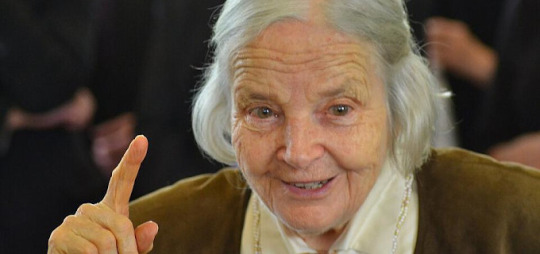
(InfoCatólica) Alma Luise Elisabeth von Stockhausen nació el 30 de septiembre de 1927 en el Nesselroder Hof de Münster (Westfalia). Era hija del abogado e historiador Franz Eduard von Stockhausen (1903-1952) de la familia noble westfaliana Stockhausen y de la condesa Elisabeth von Bernstorff (1899-1994).
Estudió filosofía, teología católica e historia en la Westfälische Wilhelms-Universität de Münster, en la Georg-August-Universität de Göttingen y en la Albert-Ludwigs-Universität de Friburgo. En 1988 fundó la Academia Gustav Siewerth con el apoyo de Joseph Ratzinger.
Dicha academia tenía como objetivo contrarrestar el marxismo y la hostilidad anti-iglesia del movimiento de 1968. También abordó la oposición entre la escolástica católica «lógica» y la «escolástica protestante». Alma advirtió que la Iglesia de esta època está asumiendo las tesis protestantes.
Su último lugar de residencia fue el santuario mariano de Heroldsbach, donde uno de sus hermanos ejerce como sacerdote. Allí murió el 4 mayo de 2020 a la edad de 92 años, a consecuencia de un cáncer.
Esta fue una de las entrevistas más sustanciosas que concedió hace unos años y que ahora ha publicado el portal austriaco Kath.net:
Señora von Stockhausen, el papa Benedicto volvió recientemente a manifestar que la crisis de la Iglesia es una crisis de fe. ¿Qué papel jugó Lutero al respecto?
¡Un papel decisivo! La crisis de la actual teología se debe a la filosofía, tal como lo dijo también el cardenal Ratzinger, antes de llegar a ser papa Benedicto. En la base de la teología hay una falsa filosofía. ¿Y cuál es esa falsa filosofía? La filosofía alemana. Y la filosofía alemana no solo está influenciada por Lutero, sino que tiene su origen en él. El mismo Heiddeger lo dice: Yo no hago más que conceptualizar a Lutero. Hegel también se entiende así.
La tesis fundamental de su nuevo libro (La sola fe: la teología de Lutero, una biografía, Gustav Siewerth Akademie, Weilheim-Bierbronnen, 2016) es que la teología de Lutero es un derivado de su biografía. Pero yo quisiera comenzar con su propia biografía. ¿Cómo fue que usted comenzó a interesarse por Lutero?
De niños, escuchamos de nuestra madre que nuestra abuela se había vuelto católica, a pesar de que su familia, los condes de Bernsdorff, eran marcadamente evangélicos. Mi abuelo hacía política para el rey de Hannover, un protestante convencido. Un día mi abuela dijo: «Ahora sí que quiero conocer a nuestro padre en la fe». Y lo hizo. Y entonces dijo a su esposo: «¿Qué clase de locura es esta en que creemos? Tengo que volverme católica inmediatamente». El abuelo respondió: «Entonces me divorcio. Si la religión no es lo que nos une, cómo será posible, pues, una vida en común?». La abuela respondió: «La verdad es la verdad, me voy a volver católica». El abuelo no se divorció y la abuela se volvió católica.
¿Qué fue lo que en aquel entonces convenció a su abuela para que se convirtiera a la fe católica?
Ciertamente, lo decisivo fue lo de que Dios tenía que ser malo. Lutero le adjudica el mal a Dios. Y eso, naturalmente, es la locura de la cual hablaba mi abuela.
¿Qué fue lo que a usted le abrió los ojos respecto a Lutero?
Yo no solo me ocupé de Lutero por razón de mi ascendencia familiar, sino sobre todo porque la filosofía alemana se remite una y otra vez a Lutero. Mi maestro más importante fue inicialmente Heiddeger, que siempre se remitió a Lutero, y decía: En mi filosofía, no he dado un solo paso sin Martín Lutero. Heiddeger era hijo de un sacristán católico, y posteriormente se volvió protestante.
¿Fue Lutero la razón para que usted estudiara filosofía?
Mis padres eran ambos filósofos. MI madre siempre me decía que mi clase de filosofía había comenzado con mi padre cuando yo tenía dos años. Así, pues, el estudio estaba prácticamente pre-programado.
Usted estudió en Münster, Munich, Göttingen y Freiburg. En Freiburg no solo conoció la revuelta estudiantil de izquierda de los años setenta, sino que también tuvo experiencias con ella.
Cuando fui profesora en Friburgo, lo más importante para mí era refutar a Karl Marx. Eso hice, y entonces ocurrió lo siguiente: en el auditorio había 300 estudiantes. Todos debían cursar filosofía, que también eran candidatos a la licenciatura en pedagogía. Todos los futuros profesores de bachillerato debían aprobar las asignaturas de filosofía. Yo, entonces, refutaba a Marx con base en sus escritos, pero a los estudiantes no les gustaba. Lo primero que hicieron fue pisotear mi micrófono y luego me arrastraron con un lazo. Ellos gritaban: «¡Hay que hacerle lo mismo que a Buback!». Buback era el fiscal general de la Repúplica Federal Alemana, que por aquel entonces fue asesinado por la «Fracción del Ejercito Rojo», una célula terrorista de izquierda. Mi asistente se puso a mi lado con el paraguas y mantuvo el lazo lejos de mi cuello. Entonces me arrastraron hasta donde el rector y el rector no estuvo dispuesto a defenderme. Por suerte, no llegaron a ejecutarme; me dejaron ir, pero no pude volver a dictar clase, eso estaba descartado. Entonces, lo único que pude hacer fue fundar una universidad privada, y así fue como fundé la Academia Gustav Siewerth en mis casas de la Selva Negra. Allí conocí a los grandes estudiosos de Lutero: Dietrich Emme y Theobald Beer, cuyos trabajos me abrieron los ojos. Comprendí que la teología de Lutero no era más que una respuesta a su biografía: su intento de achacarle a Dios su vida anterior y sus fatales pasiones.
Una clave para comprender la doctrina luterana fue su correspondencia epistolar con el humanista Erasmo de Rotterdam. ¿De qué hablaban en ella?
De la voluntad esclava. Lutero le escribió: «Tú, Erasmo, fuiste el único en comprenderme acertadamente. A mí no me importa lo del comercio con las indulgencias, ni lo del purgatorio y el papado, sino única y principalmente el asunto de la voluntad esclava. No es el hombre el que es culpable, sino el Dios injusto». Y Lutero continúa: «Dios dejó que Adán cayera, Dios determinó que Judas fuera un traidor, Dios es malo y nos creó por aseidad [atributo de Dios, por el cual existe por sí mismo o por necesidad de su propia naturaleza] del mal. Dios tiene que volverse primero diablo antes de poder volverse Dios», es decir, él tiene que deponer su maldad, hacerla diablo, y entonces puede volverse Dios.
¿Es decir, que no es el hombre el que es malo, sino Dios?
Lutero dijo: No es el pobre hombre el que es culpable, sino el Dios injusto. Dios es cruel y malo. Él primero descargó su maldad en Cristo y luego sobre nosotros, de manera que nuestro único nombre –como Lutero dice– es el pecado. En cierto sentido, nos hemos convertido en las bestias de carga de Dios, tenemos que ser malos. Yo entiendo que Lutero quiere siempre demostrar que él es inocentemente malo. Él personalmente no puede hacer nada en contra, él tiene que llevar la carga de la maldad de Dios y por eso «fornicar y asesinar» permanentemente, como él mismo dice. Literalmente: «Incluso si fornico mil veces al día y mil veces asesino, eso no puede apartarme de Cristo. La sola fe me salva». Somos redimidos por la muerte y resurrección de Cristo. Para Lutero, Él también tiene la función de redimir al mundo del mal.
¿Para Lutero, qué papel juega Satanás, el Adversario?
Un papel totalmente central. Él dice que somos los esclavos del diablo y tenemos que hacer siempre lo que él nos dice. En sus escritos, el diablo aparece mencionado miles de veces, y en ellos siempre se remite una y otra vez al diablo.
¿Cuáles son las consecuencias si el hombre no tiene libre albedrío?
Este el punto decisivo de la teología luterana. Con mi libre albedrío me puedo decidir por o en contra de Dios. Pero si, como Lutero, creo que no tengo libertad, entonces el mal en el mundo tiene que venir de Dios, entonces estoy predestinado para el mal. Para Lutero, Dios sería un ídolo si nos diese la libertad, pues entonces no podría determinar todo él solo con sabia previsión, sino que tendría que respetar nuestras decisiones.
¿Entonces, qué papel juega el mal si el hombre no puede decidirse ni por el mal ni contra el mal?
El mal es la cualidad de Dios, dice Lutero. Y eso es consecuente si se quiere exonerar de su propia culpa. Aquí es donde aparece el aspecto biográfico. Siendo estudiante, Lutero apuñaló –seguramente sin intención– a un compañero, y en seguida huyó a un convento. Cuando quiere decir que él es inocente, entonces tiene que decir que el mal ocurre por predestinación, por Dios. Dios predestina al mal. Lutero repite esto con frecuencia.
¿Entonces, cómo son posibles el arrepentimiento, el perdón y la gracia?
Según Lutero, son innecesarios, completamente innecesarios. Arrepentimiento y perdón son insinuaciones del demonio que no tienen ningún sentido. Pues la sola fe, y no nuestras obras, es lo que, según Lutero, nos asemeja a Cristo y nos da la vida eterna. No importa qué hagamos, si asesinamos, o fornicamos, o maldecimos sin cesar: nada podrá separarnos de Cristo, esto es lo que afirma Lutero.
¿Si el hombre no posee libre albedrío, y por eso tampoco es responsable de sus pecados, entonces, según Lutero, para qué murió Cristo en la Cruz?
Por el pecado del Padre. Lutero lo dice así: el Padre es malo, él no es nuestro Padre, él no solo es nuestro adversario, sino también el adversario de Cristo, pues él mató una primera vez a Cristo en el cielo, y luego otra vez delante de todo el mundo en el Gólgota.
¿Si solo basta la fe en Cristo y el hombre no posee libre albedrío, no significa esto, como última consecuencia, que un asesino creyente llega primero al cielo que un samaritano que duda, y que a un creyente le está permitido practicamente todo?
Lutero cree que la prostituta llega antes al cielo que un santo, pues la prostituta no es hipócrita. Para él, los santos solo son hipócritas. Lutero creía que el hombre no puede hacer otra cosa que fornicar, pues es su naturaleza. Debe hacerlo; Dios lo obliga a hacerlo.
¡Al parecer, tuvo más experiencias con prostitutas que con santos!
El dice que fornicaría diariamente mil veces de pensamiento. Y también dice: Junto a mi Cata [la mujer de Lutero se llamaba Catalina] tengo a tres más en los brazos. Y si la «señora» no quiere hoy, entonces agarro a la criada.
Lutero enseñó la justificación «solo por la fe» (sola fide) y con ello solapa los sacramentos. Para él, estos ya no son necesarios para la redención. ¿No implicaría esto que la Iglesia, como dispensadora de los sacramentos, es superflua?
¡Por supuesto! Para Lutero, el papa es el mayor Anticristo.
¡Pero entonces la iglesia evangélica también es superflua!
¡Por supuesto! Solo hay el sacerdocio común. Lutero enseñó que «todos salimos reptando del bautismo como hombre, mujer, sacerdote, obispo, cardinal y papa». Entonces solo se necesita a la iglesia para transmitir la fe, pero ya no para los sacramentos.
En el fondo, él solo quería una iglesia meramente teológica y no una sacramental.
Para Lutero ya no hay más una Iglesia sacramental y tampoco la Iglesia estructurada jerárquicamente. En el fondo, solo hay laicos, el sacerdocio común, como él lo llama. Entonces, todos pueden reunirse y perdonarse mutuamente los pecados. Para Lutero, la misa era «el mayor de los horrores». Con la abolición de la misa, Lutero también abolió el papado. Según él, «el horror de la misa» es la causa de que exista el papado, que supervisa, que dispone la ordenación sacerdotal, etc., pero él no necesita nada de eso. Lutero propagó la total disolución de la jerarquía eclesiástica y el sacerdocio eclesiástico.
¿No es la renuncia a la Iglesia sacramental la clave para entender la actual crisis de la teología, de la pérdida de la cultura y la moral, de la disolución de la familia como pilares de la sociedad?
Sí, con toda seguridad, pues para Lutero el matrimonio es una «cosa mundana», que no se contrae delante de Dios. Lutero se casó intercambiando los anillos durante una cena, y dijo a sus amigos: Con esto me caso con Catalina de Bora. Desde ahora estoy preso, atado a mi Cata. Pero si la «señora» no quiere, que venga la criada, dijo para consolarse.
¿Qué consecuencias tiene para una sociedad si el pecado es declarado como algo inevitable?
La disolución de la familia y, con ello, la ruina de la sociedad.
¿Cómo siguió desarrollando Hegel las ideas de Lutero y cómo marcó Lutero la filosofía hegeliana?
Hegel dice: «Si los teólogos llegan a la desesperación de ver en Dios el mal mismo, entonces solo queda refugiarse en la filosofía». Lutero ve en Dios mismo el mal. Hegel, entonces, quiere mostrar filosóficamente que el mal en Dios es solo el «supuesto mal»; Dios es en sí bueno. Si Dios, como ser abarcador supremo, tiene que ser malo, entonces el no-ser es la manera como hay que determinar el mal. El mal es siempre lo destructor, lo no bueno. Así, pues, Dios ya no es más la simplicidad del ser indiviso, sino tiene que ser presentado como como una totalidad de partes. Pero si Dios es una totalidad de partes, entonces Dios mismo debe ver cómo conoce esas sus partes. ¿Y cómo lo hace? Al poner delante de él sus partes, evoluciona. Dios pone delante de él sus partes y al siguiente paso las vuelve a suprimir. Así, pues, mediante la negación de la negación se llega a la posición, es decir: evolución.
¿Hasta qué punto Hegel influyó en Darwin y en su teoría de la evolución?
Nietzsche reflexionó al respecto, y dijo: «Sin Hegel no hay Darwin», ¡y con toda razón! Nietzsche dijo además: «Pero el viejo Moisés dijo que no puedes matar. Pero Darwin dijo: debes matar». Esto es lo que Hegel piensa con su «mediante la negación de la negación a la posición». A este respecto, Nietzsche comenta lo siguiente: «El secreto de la historia es la guerra» Hitler se inspiró en Nietzsche cuando desató la Segunda guerra mundial. Karl Marx saca de la evolución superior mediante selección la última consecuencia de la historia. Si la evolución es la manera como se desarrolla lo divino, entonces eso significa que la naturaleza devendrá espíritu. Y cuando la naturaleza devenga espíritu con el hombre como eslabón último del desarrollo, entonces el hombre podrá consumar la reproducción de la evolución.
¿Pero no se sobrevalora con esto la influencia de Lutero? Parece como si esta interpretación hiciera de Lutero un genio fatal, el padre de la modernidad.
Él es con seguridad el padre de la modernidad. Él no es un genio, pero sí es el que adjudicó el mal a Dios, y de esta manera realiza la reiteración potenciadora de la culpa original: «querían ponerse en el lugar de Dios». Con la teoría de la evolución nos hemos puesto en el lugar de Dios. ¿Encontrará aún fe el Hijo del hombre cuando vuelva? Esta es realmente nuestra situación.
¿Cómo podemos detener este funesto desarrollo? ¿Cómo puede ser superado Lutero en la teología y la filosofía?
Hay que mostrar que la teología de Lutero no es más que su autobiografía, la autojustificación de sus pasiones pecaminosas al achacarle el mal a Dios.
Traducido por LCH para InfoCatólica
1 note
·
View note
Text
FOMA 23: German Post-War Modern
As a result of the devastating destructions of the Second World War architects in postwar Germany were faced not only with the rebuilding of cities but also with the opportunity to break with the past and follow new paths.

Children in bombed out Berlin in 1945. | Photo Otto Donath via Berliner Ferlag
The following five buildings represent Forgotten Masterpieces of German postwar architecture that deserve a closer examination.
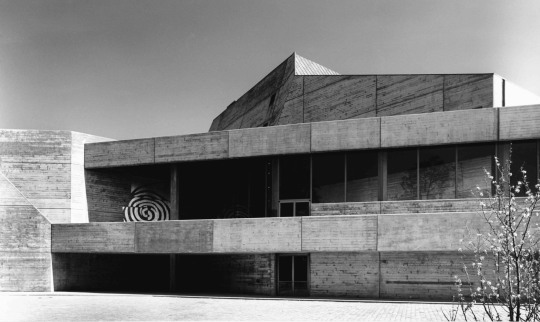
The theater captured shortly after its completion in 1966 by Sigrid Neubert. | Photo via Baunetz
The first building is the Municipal Theater in Ingolstadt by Hardt-Waltherr Hämer and his wife Marie-Brigitte Hämer. Hämer is best known for his Berlin works, where he eloquently proposed a cautious renewal of the city and its quarters.
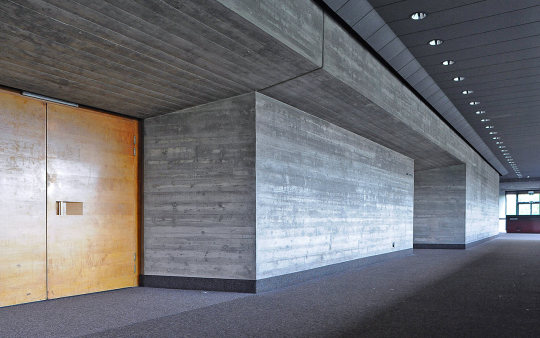
Interior view of the theater around 2009. | Photo via Breitschaft Architekten
The theater, designed and built between 1960 and 1966, is undoubtedly a prime example of German Brutalism that takes a bold modern stand within the city center of Ingolstadt: with its board-marked concrete surfaces and complex, interlocking interiors makes for interesting spatial experiences that are faintly reminiscent of Hans Scharoun‘s Berlin Philharmony.
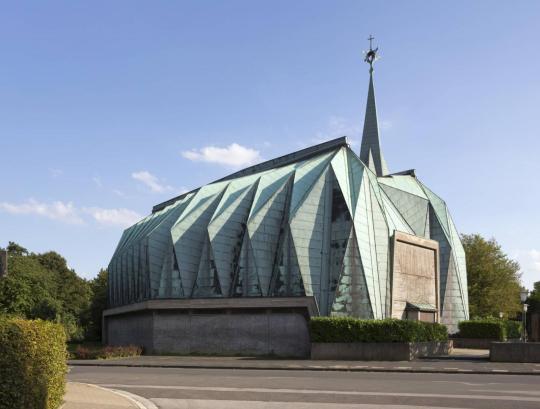
View of the church from Northwest. | Photo by © Florian Monheim
As the followers of my Tumblr might have recognized I have a major knack for postwar church architecture in Germany and beyond. One of the most interesting examples of postwar modern church architecture in Germany is St. Paulus in Neuss in the lower Rhine region, a congenial collaboration between architects Fritz and Christian Schaller and engineer Stefan Poloyni.

View from East into the nave. | Photo by © Florian Monheim
On a hexagonal plan they created an awe-awaking space that is crowned by a spherical, folded and diamond-shaped vault. The church quintessentially represents the inventiveness of architects faced with the task of designing contemporary religious architecture: a spectacular, technologically innovative space that relies on the interplay of light and shadow to create a contemplative yet solemn atmosphere.
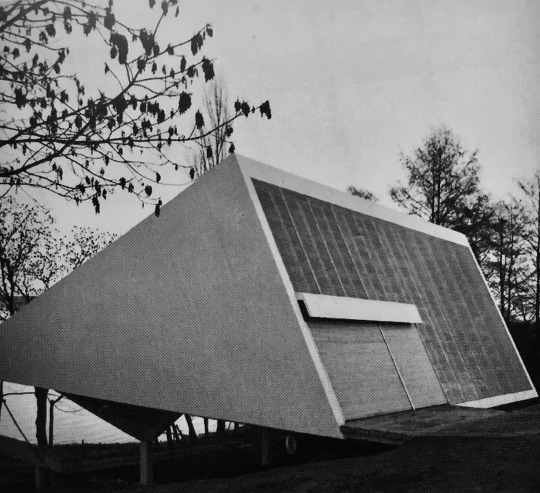
Moroshito after completion in 1961. | Photo via SAII
The summer house Moroshito, which Paul Stohrer designed for himself at Lake Constance, is a very unusual example of German postwar modernism and as such a favorite of mine. In its wedge-shaped design Stohrer processed influences from Oscar Niemeyer, a reference rarely present in German postwar architecture, and also gave expression to his colorful personality, which not only included a life-long passion for painting, but also for flamboyant sports cars.
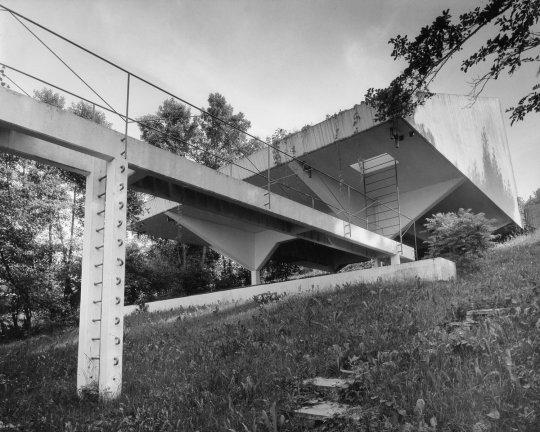
The house's little bridge leading to the waters of Lake Constance. | Photo via Ruppenstein
Free from a client’s restriction Stohrer realized a house that was tailor made to his needs and gave him the freedom to play with shapes, materials and plans.
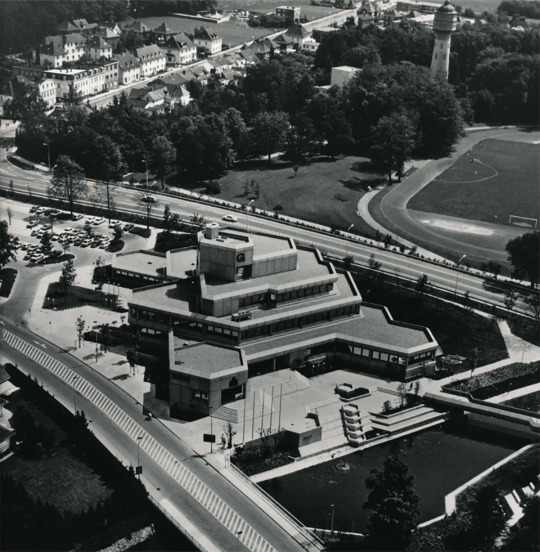
Aerial view of the town hall in 1975. | Photo via Baunetz
Harald Deilmann’s design for the Town Hall Gronau, a city on the German-Dutch border, represents a multi-functional approach to town halls in Germany in the 1960s and 1970s.
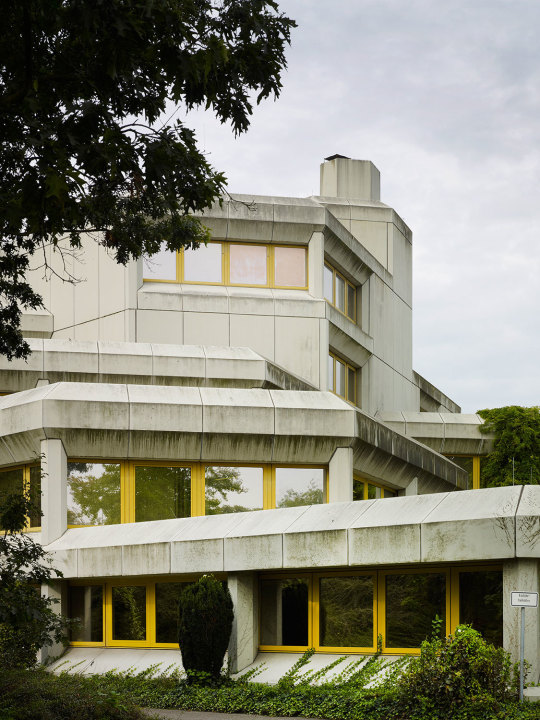
The town hall in 2016. | Photo by © Christian Richters
The scaled design houses a multitude of rooms, office, meeting places and with its raw concrete facade gives expression to the increased artistic freedom architects sought in these years. The building ranks among the most interesting yet overlooked examples of brutalism town hall architecture in Germany after WWII.
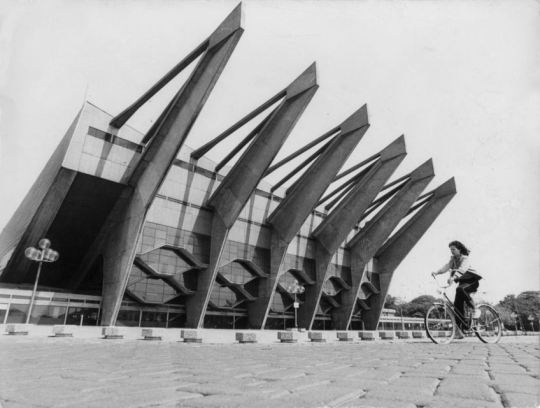
The Stadthalle in c. 1964. | Photo via Wesser Kurier
Last example of the architectural self-confidence of cities in postwar Germany is the Stadthalle in Bremen by Roland Rainer, built between 1961 and 1964. Rainer’s idea was to form a structural unity of a roof and stands, an idea that resulted in a suspension roof spanning more than 100 meters.

The Stadthalle was in 2000 renamed to AWD Arena. | Photo via Ortsamtwest
Due to the resulting expressive construction the Stadthalle soon became one of the city’s landmarks and together with the Stadthalle in Vienna and the one in Ludwigshafen forms a trilogy of Rainer’s successful civil engineering works.
--
#FOMA 23: Phillip Ost

Phillip Ost studies art history at Westfälische Wilhelms-Universität Münster, a middle-sized town in the Northwest of Germany. He focuses on postwar art and architecture in Germany and beyond with a special emphasis on postwar church architecture and German Art Informel. In 2014 he established German Post-War Modern, initially intended to serve as his personal visual archive of largely forgotten modernist architecture in Germany.
245 notes
·
View notes
Text
Psychologen entwickeln Modell zur Integration von Flüchtlingen
Psychologen entwickeln Modell zur Integration von Flüchtlingen
Münster/Bremen (fs) – Nach Angaben der Vereinten Nationen sind derzeit mehr als 79 Millionen Menschen auf der Flucht – sie werden auf absehbare Zeit nicht wieder in ihre Heimat zurückkehren. Psychologen der Universität Münster haben jetzt ein Modell entwickelt, mit dem die psychologischen Faktoren analysiert werden können, von denen eine erfolgreiche Integration in die aufnehmenden Länder…
View On WordPress
#Erzwungene Migration#Flüchtlinge#Gerald Echterhoff#Integration#Jens Hellmann#PARI#Perspectives on Psychological Science#Psychological Antecedents of Refugee Integration#Psychologie#Sicht der Betroffenen#Westfälische Wilhelms-Universität Münster
0 notes
Text
AfD-Programm steht im Widerspruch zur Katholischen Soziallehre
AfD-Programm steht im Widerspruch zur Katholischen Soziallehre
Eine Studie der Westfälischen Wilhelms-Universität (WWU) Münster und der Hochschule für Philosophie München bewertet die Grundpositionen der Partei „Alternative für Deutschland“ (AfD) aus sozialethischer Perspektive und kommt zu dem Schluss, dass sie mit den Prinzipien der Katholischen Soziallehre unvereinbar sind.
Die Autoren um Marianne Heimbach-Steins (Münster) und Alexander Filipović…
View On WordPress
#AfD#Alexander Filipović#Alternative für Deutschland#Hochschule für Philosophie München#Marianne Heimbach-Steins#Westfälische Wilhelms-Universität Münster
0 notes
Text
Physik: Geschlechtergerechte Photonen - geschlechtergerechte/r Quark/s
Physik: Geschlechtergerechte Photonen – geschlechtergerechte/r Quark/s

Gendergerechte Thermodynamik, gendergerechte Halbleiterphysik, gendergerechte Induktionsgesetze, gendergerechter Magnetismus, elektrostatische Genderforschung, magnetostatische Genderforschung …
Die Zukunft der Physik ist gendergerecht also besser zurück in die Vergangenheit mit einem Teilchenbeschleuniger Ihrer Wahl.
Manche Ausschreibungen sind schlicht nicht kommentierbar. Deshalb…
View On WordPress
0 notes
Text
Missbrauch im Bistum Münster: Studie wird am 13. Juni veröffentlicht
Die Westfälische Wilhelms-Universität Münster hat heute bekannt gegeben, dass am 13. Juni die Ergebnisse Untersuchung sexuellen Missbrauchs im Bistum Münster veröffentlicht wird Hierzu erklärt der Bischof Felix Genn in einem Schreiben an Haupt- und Ehrenamtliche im Bistum Münster: „Ich bin den Wissenschaftlern der WWU Münster dankbar, dass sie sich der schwierigen Aufgabe der https://de.catholicnewsagency.com/story/missbrauch-im-bistum-muenster-studie-wird-am-13-juni-veroeffentlicht-10537
0 notes
Text
Historie - Der Kaiser und die Wissenschaften
Aus der PAZ: »Die Westfälische Wilhelms-Universität Münster möchte sich vom Namen ihres Stifters trennen, da sie diesen für historisch belastet hält. Dabei hatte die Wissenschaft im Laufe der Geschichte selten einen Förderer in der Politik wie Wilhelm II. http://dlvr.it/SmwK6Q «
0 notes
